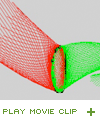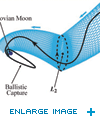Space Travel:
Mathematics Uncovers an Interplanetary Superhighway
Tubes
The orbits around Lagrange points have tube-shaped surfaces attached to them. For example, a spacecraft given the proper initial velocity can be sent along a trajectory that would then carry it into orbit around, for example, Earth's L2 point (in the Sun-Earth gravity field). The collection of all similar trajectories forms one tube of the interplanetary transport network (green mesh). The important physical property of the tube is that anything that shifts from an orbit that is around a planet to an orbit that lies outside must pass along them.
A spacecraft on a trajectory inside this tube will pass L2 and head toward the outer solar system (blue line), whereas one on a trajectory to the outside will fly back toward the Sun (red line). The tube's outer surface is an example of what mathematicians call a stable or unstable manifold (see box at the lower right).
The tube shown is an approaching tube, as it approaches the Lagrange point neighborhood. But all tubes come in approaching and departing pairs.
 Like water directed by a hose, the set of possible planet-passing objects is imagined to flow along these tubes, but in six dimensions instead of just three. (The tubes "live" in a six-dimensional space; three coordinates of position plus three coordinates of velocity. But they are usually shown as projected onto the three-dimensional position space or the two-dimensional orbital plane of the massive bodies.)
Like water directed by a hose, the set of possible planet-passing objects is imagined to flow along these tubes, but in six dimensions instead of just three. (The tubes "live" in a six-dimensional space; three coordinates of position plus three coordinates of velocity. But they are usually shown as projected onto the three-dimensional position space or the two-dimensional orbital plane of the massive bodies.)
 It's important to emphasize that tubes exist for Lagrange points throughout the solar system. In the figure at right, a spacecraft inside a tube approaching the L2 point of one of Jupiter's moons (a.k.a., a Jovian moon) will find itself going from an orbit around Jupiter to an orbit around the moon. The tubes are the mechanism by which ballistic, or unfueled capture, can occur.
It's important to emphasize that tubes exist for Lagrange points throughout the solar system. In the figure at right, a spacecraft inside a tube approaching the L2 point of one of Jupiter's moons (a.k.a., a Jovian moon) will find itself going from an orbit around Jupiter to an orbit around the moon. The tubes are the mechanism by which ballistic, or unfueled capture, can occur.



